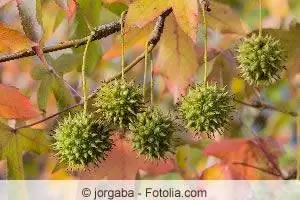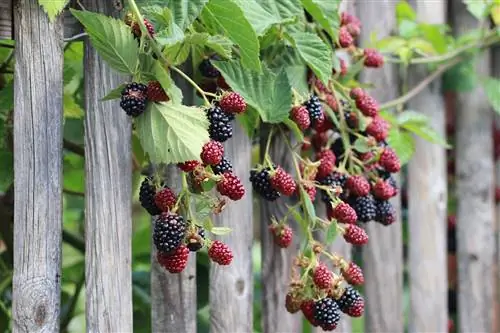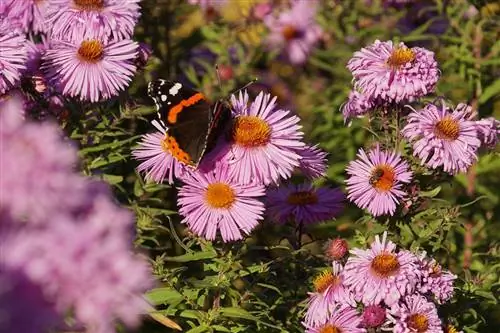- Author admin [email protected].
- Public 2023-12-17 03:39.
- Last modified 2025-01-24 12:45.
With the globe amber tree, Liquidambar styraciflua Gumball, the garden receives a design accent, because the round crown of the Liquidambar styraciflua Gumball looks very decorative. The dwarf yellow amber tree Gumball can grow up to five meters high. In addition to decorative flowers that adorn the deciduous tree with long green clusters and later with spherical fruits, the spherical amber tree stands out especially in autumn with its intense autumn color. It ranges from orange to purple. The ornamental tree does not require much care and tolerates the German winter well. Adult trees are frost tolerant down to -23 °C.
Demands & Soil
The Liquidambar styraciflua Gumball needs a sunny location. A light shade is just tolerated by the light-hungry tree. A sheltered location is an advantage because the spherical crown offers a large surface area for strong winds to attack. The sweetgum tree requires slightly acidic and nutrient-rich soil. The substrate can be sandy-loamy with a pH between five and seven. The soil should be around one meter thick so that the tree can find good support. The Gumball is not suitable for underplanting. It needs loose soil around its trunk. By the way: the brighter the tree is, the more intense the autumn color will be!
Plants
Spring or summer is the best time for this. The decorative tree then has enough time until autumn to take root well. The location should be chosen carefully, as the gumball's crown can reach up to four meters in diameter over the years. The annual growth is around 20 cm. Once the Gumball has reached its full-grown height, it will stop growing over the years. Only the trunk becomes thicker and changes its color from reddish brown to grayish brown. Its bark is corky. This is how it's done:
- Water the tree before planting until no more air bubbles emerge from the root ball
- Dig a sufficiently large planting hole, at least twice the size of the root ball
- add some compost to the planting hole as a growth accelerator
- Place the amber tree in the middle of the planting hole
- distribute the excavation all around the planting hole and stabilize the tree
- Tamp down the soil and water it
- possibly put two support posts aside for the first time
Tip:
Do not plant the sweetgum tree too close to a property line or the house wall so that the crown can develop well.
Fertilize
The globe amber tree does not need to be fertilized if it grows in nutrient-rich soil. If fertilizer is applied in spring, the deciduous tree produces its decorative green flowers, which hang down in long clusters, from May onwards. In autumn, August is recommended for fertilization. Then new shoots that the tree develops in response to the fertilizer application continue to mature until the onset of the frost period. Garden compost is particularly suitable for fertilization. Gumball also tolerates mineral fertilizer well.

Care measures
The sweetgum tree is a heartroot plant. It forms many strong main roots that grow in all directions and in depth. To prevent the soil around the gumball from becoming too dense, the area around the tree should be loosened with a hoe several times a year. Loosening the soil avoids waterlogging, which the sweetgum tree cannot tolerate. The loose soil allows moisture to drain away easily.
Tip:
Work carefully so as not to injure the heart roots!
Pouring
The sweetgum tree actually copes well with the Central European climate. However, if a dry period lasts too long, the sweetgum tree needs to be watered. Young trees in particular rely on additional watering in dry times.
Cutting
The densely branched, closed growth of the crown is intended by the breeder to be round. The shape does not need to be cut. However, crooked or criss-crossing branches can be removed in spring. Frozen branches and shoots that are growing in the wrong direction are also cut. Remember: When cutting, you cut into he althy wood!
Tip:
Frozen branches do not develop leaves and are easy to recognize!
Wintering
Young gumball trees should be protected against frost. The fallen leaves are left on the ground around the tree. It forms a dense blanket over the root system. When the leaves rot, they still serve as nutrients for the sweetgum tree. The bark of the still young trunk is wrapped with garden fleece from autumn to spring to protect it from frost.
Pests & Diseases
The sweetgum tree is largely resistant to leaf pests and fungi. Some specimens in an unfavorable location can be attacked by anthracnose. This is a fungal disease that causes wilted flowers and spots on the leaves. The affected plant parts must be removed and burned. If it is not possible to contain the fungus, the sweetgum tree will die. Another pest are aphids. They prefer to attack the young buds. Any visible leaf spots are caused by road s alt.
Propagate
- Propagation by seeds: The seeds of the gumball tree are cold germinators. They require a period of cold before the seed germination process is activated. The seeds obtained from the inconspicuous fruits are therefore placed in the ground in the cold frame in autumn. Winter is the natural cold stimulus for the seeds. In spring the first germs appear in the cold frame.
- Propagation by cuttings: To do this, shoots with a length of around 15 cm are cut off from the sweetgum tree in the summer. The lower leaves are removed. Rooting should be successful in a moist growing substrate at warm temperatures. The cutting shows this with a new shoot. The rooted cuttings will not be planted outdoors in a protected, sunny spot until next spring.
Frequently asked questions
Where is the sweetgum tree used?
The Gumball is a solitary tree. It is a house tree and comes into its own in selected places. The large maple-like leaves are a decorative leaf decoration all year round.
How did Gumball get its name?
The tree's sap was once used to make chewing gum in North America. The name also refers to the spherical shape of the crown.
How tall will the trunk be?
A tree around 350 cm tall has a trunk height of 160 cm to 180 cm.
What else sets Gumball apart?
He is particularly weak. He gains height through his crown.
How long does it take for Gumball to grow up?
A height of five meters is reached in 10-15 years, depending on the location.
Can foliage color be influenced by fertilizer?
No, it depends on the climatic conditions. A dry, cool autumn without frost colors the leaves particularly beautifully.
What you should know about globular sweetgum trees in brief
Amber trees belong to the witch hazel family and come from North America. Not all trees on offer are hardy in our Central European climate.
Liquidambur styraciflua, also called storax tree or starfish tree, is suitable for our home gardens, but requires a lot of space. It grows very large and the crown is quite expansive. Sweetgum trees are mainly known for their great autumn colors (Indian summer). The globe amber tree is usually Liquidambar styraciflua 'Gumball'. This tree grows to around 5 meters high and forms a spherical crown. When it comes to crown refinement, the tree doesn't get any taller than when you buy it. The trunk has already reached its final height. Only the crown grows. The trunk just gets thicker.
Location
- the tree likes sunny places
- A location sheltered from the wind is best, otherwise the tree will lose its leaves too quickly in autumn
Planting substrate
- A moderately moist, loose and deep clay soil is ideal
- The tree grows only slowly on sandy soils
- Yellowing of the leaves indicates too much lime in the soil
Plants
- Plant in spring if possible, so the roots can spread well until next winter
- The sweetgum tree loves open ground, so don't plant under it if possible
- Roots are sensitive to soil compaction, so do not plant on paths and seats
Watering and fertilizing
The sweetgum tree needs plenty of water. Its roots are sensitive to drought, especially in the first few years you should not let them dry out. Of course, standing moisture should be avoided.
- Provide nutrients moderately with mineral fertilizer every 14 days
- So that the young shoots mature by winter, special fertilization is recommended by August at the latest
- do not fertilize after August
- If fertilization is too high, the autumn color is usually sparse
Cutting
- a cut is not necessary
- the tree grows in shape alone
- Thinning out every now and then helps prevent the crown from becoming too dense
- Thinning important for the rejuvenation of the crown
- do not cut in spring when the sap is rising
- otherwise you can always cut
Wintering
For young trees, you should pile up leaves around the tree disc. Older trees usually get through the winter without any problems.
Propagate
- Propagation by seeds or cuttings
- Cut cuttings in spring or autumn
- they root best in a mixture of sand and peat moss
- Store seeds in the refrigerator for a few weeks before sowing
Diseases and pests
- very robust tree
- almost resistant to pests
- Aphid infestation is sometimes possible when the leaves emerge
- Roots sensitive to drought
Conclusion of the editors
The globe amber tree is a very popular garden tree, especially for front gardens, as an eye-catcher. He is quite easy to care for. All you have to do is water it, especially when it's dry. Then the tree needs tons of water. Otherwise it hardly needs any care. The important thing is the right location, then the globe amber tree will thrive on its own.






